纤维素研究综述(DOC)
- 格式:doc
- 大小:758.00 KB
- 文档页数:11

纤维素综述简述:微晶纤维素是天然纤维素的水解产物,外观呈白色或类白色,是一种晶形粉末产品,不溶于水,性质稳定,与主药不发生化学反应。
作为填充剂,适量用于处方中,可以使制得的颗粒较松散,均匀细小,结合性能好,同时,由于它吸水后能使片子迅速膨胀而崩解,因此,它又是一种良好的崩解剂。
近年来,作为一种新型辅料,微晶纤维素在片剂生产制造中的应用越来越广泛。
在近些年的新产品开发研制,原有产品处方的改进及不合格中间产品的再处理等方面,均在不同程度上使用了这一新型辅料,并收到了良好的效果。
用于新处方设计中由于微晶纤维素具有良好的结合性与崩解性,因此在开发研制新产品时,它是一种优先选用的辅料,微晶纤维的作用要强于其它类似辅料如淀粉、糊精等。
这在处方设计时,我们优先选用了微晶纤维素,经过数次处方调整与试验,当微晶纤维素在片中的含量达到0.025g/片时,生产出的片子结合很好,具有足够的硬度。
制法:微晶纤维素可用稀无机酸溶液将α-纤维素控制水解制得,α-纤维素可从含纤维素植物的纤维浆制得。
水解后的纤维素经过滤、提纯、水浆喷雾干燥形成干的。
粒径分布广泛的多孔颗粒。
应用:解决因工艺带来的问题有些产品的工艺是在迁就产品达到某些指标情况下制定的,一旦工艺变化就会带来诸多问题。
例如新速效感冒片,在原处方基础上,为了保证其溶出度符合药典规定,在工艺上不得已将颗粒制得比正常的软一些,打片时打片机的压力也要尽量小一些,使得打出的片子硬度低。
在进行薄膜包装时,常常会造成很多碎片,使得成片率降低,为了提高成片率就必须提高片子的硬度。
要提高硬度,又不影响溶出度,就要改变原处方,这时微晶纤维素又是一个良好的优选辅料。
生产中,压力提高后,我们用一定量的微晶纤素取代了原处方中相应量的某些其它辅料,当其用量达到。
片时,收到了良好的效果。
片子的硬度由原来的提高至,同时其溶出度也很好,完全符合质量要求。
用于不合格中间体的再处理有时制出的片子鼓盖掉盖,裂片或崩解超限。
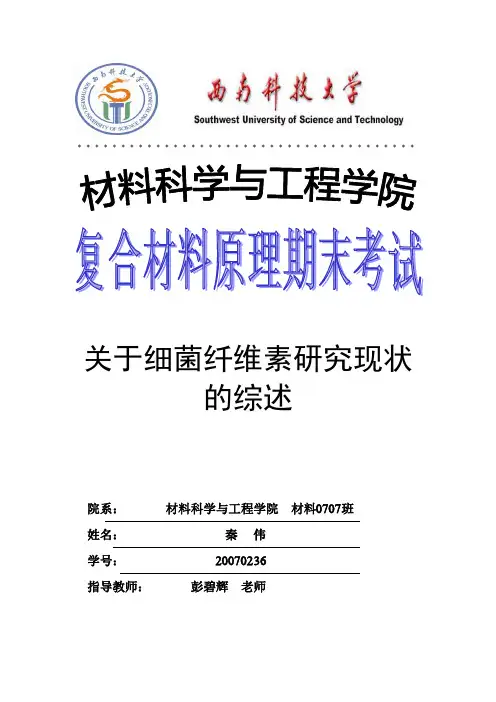
﹡﹡﹡﹡﹡﹡﹡﹡﹡﹡﹡﹡﹡﹡﹡﹡﹡﹡﹡﹡﹡﹡﹡﹡﹡﹡﹡﹡﹡﹡﹡﹡﹡﹡﹡﹡﹡﹡﹡关于细菌纤维素研究现状的综述院系: 材料科学与工程学院 材料0707班姓名: 秦 伟学号: 20070236指导教师: 彭碧辉 老师细菌纤维素研究现状[摘要]: 本文从细菌纤维素的合成入手,列举了细菌纤维素合成研究过程中的研究点,其中包括了对合成过程的研究、发酵工艺及设备的改进以及细菌纤维素复合材料的研究等,最后对未来细菌纤维素发展趋势作出了展望。
[关键词]:细菌纤维素;发酵工艺;细菌纤维素复合材料The Bacterial cellulose researchsituation[abstrcat]: From the synthesis of bacterial cellulose, liststhe synthesis process of bacterial cellulose research points,including the synthesis process of the research, the fermentation process and equipment improvement and bacterial cellulose composites for future research, development trend of bacterial cellulose is forecasted.[key words]: bacteria cellulose; Fermentation; bacteria cellulose composites细菌纤维素发现至今已有100多年的历史,由于对其物理特性了解不够充分,以致应用受到限制。
最近十几年,随着对其生物合成机制的深入了解以及发酵条件的改善,加速了细菌纤维素的工业应用。
细菌纤维素[1](bacterial cellulose, BC),是由β-1, 4-糖苷键连接而成的天然聚合体,细菌纤维素的化学纯度非常高,具有良好的生物可降解性;它具有精致的天然超微纤维网状结构,这种网状结构是由一种天然形成的纳米纤维构成,其直径仅为 1. 5 nm。
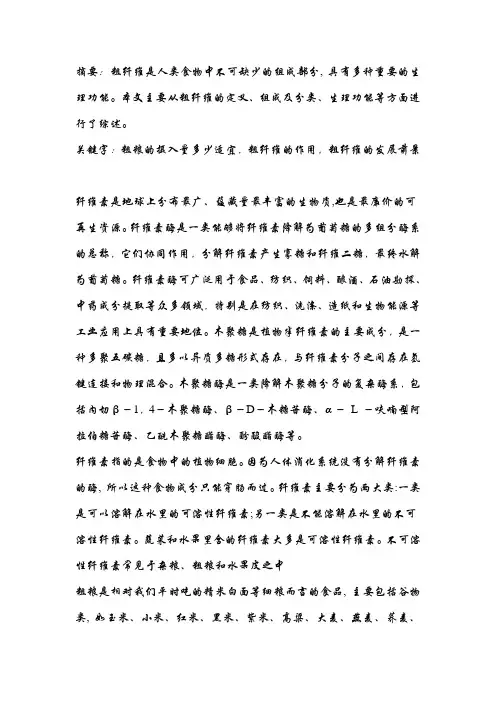
摘要:粗纤维是人类食物中不可缺少的组成部分, 具有多种重要的生理功能。
本文主要从粗纤维的定义、组成及分类、生理功能等方面进行了综述。
关键字:粗粮的摄入量多少适宜,粗纤维的作用,粗纤维的发展前景纤维素是地球上分布最广、蕴藏量最丰富的生物质,也是最廉价的可再生资源。
纤维素酶是一类能够将纤维素降解为葡萄糖的多组分酶系的总称,它们协同作用,分解纤维素产生寡糖和纤维二糖,最终水解为葡萄糖。
纤维素酶可广泛用于食品、纺织、饲料、酿酒、石油勘探、中药成分提取等众多领域,特别是在纺织、洗涤、造纸和生物能源等工业应用上具有重要地位。
木聚糖是植物半纤维素的主要成分,是一种多聚五碳糖,且多以异质多糖形式存在,与纤维素分子之间存在氢键连接和物理混合。
木聚糖酶是一类降解木聚糖分子的复杂酶系,包括内切β-1,4-木聚糖酶、β-D-木糖苷酶、α-L -呋喃型阿拉伯糖苷酶、乙酰木聚糖酯酶、酚酸酯酶等。
纤维素指的是食物中的植物细胞。
因为人体消化系统没有分解纤维素的酶, 所以这种食物成分只能穿肠而过。
纤维素主要分为两大类:一类是可以溶解在水里的可溶性纤维素;另一类是不能溶解在水里的不可溶性纤维素。
蔬菜和水果里含的纤维素大多是可溶性纤维素。
不可溶性纤维素常见于杂粮、粗粮和水果皮之中粗粮是相对我们平时吃的精米白面等细粮而言的食品, 主要包括谷物类, 如玉米、小米、红米、黑米、紫米、高粱、大麦、燕麦、荞麦、麦效等。
杂豆类, 如黄豆、绿豆、红豆、黑豆、青豆、芸豆、蚕豆、豌豆等。
块茎类, 如红薯、山药、马铃薯等。
由于加工简单, 粗粮的口感有些粗糙, 但也正因为此, 粗粮中保存了许多细粮中没有和含量较少的精品成分。
如植物纤维、“肮酶”抑制剂、丰富的维生素、富含多种微量元素等。
粗粮的种类丰富, 不同的粗粮的营养成分也不尽相同, 如燕麦富含蛋白质;小米富含色氨酸、胡萝卜素;豆类富含优质蛋白;高粱含脂肪酸高, 还有丰富的铁薯类含胡萝卜素和维生素C。
对于粗粮, 我们既要多吃, 又不宜吃多, 因为过食粗粮也有坏处, 粗细搭配, 才是科学的饮食原则两种纤维素各有各的作用。

纤维素合酶的结构及细胞壁中纤维素的合成过程(综述)莫文洲(中国农业大学农学与生物技术学院植物108,1001080823)摘要:纤维素地球上最丰富的生物大分子和最重要的可再生资源,,植物纤维素的生物合成需要多个纤维素合成酶与其他相关酶,本文综述了从蛋白结构和基因组成上总结了纤维素合酶的特点以及植物细胞壁中纤维素合成的过程。
关键词:纤维素合酶纤维素的合成纤维素是地球上数量最多的有机大分子物质,是构成细胞壁的基础物质,占初生细胞壁物质的20%~30%。
纤维素分子是由β(1-4)连接的D-葡聚糖组成的高分子聚合物,并通过分子内氢键使其形成一种类螺旋状的结构。
随着社会的快速发展,人类对植物纤维的需求激增,而过度利用自然界的植物纤维资源将对人类生存造成极大的破坏。
植物纤维素生物合成机制的研究对材质改良,木材定向培育以及农业、造纸等化工业都十分重要。
而纤维素主要有纤维素合酶来合成,所以对植物纤维素台酶基因及其蛋白的研究显得更有价值。
要掌握纤维素合成酶基因的调控。
1.纤维素合酶的结构1.1纤维素合酶蛋白结构特点在不同植物的纤维素合成中,不同的纤维素合成酶(CesA)基因的具体作用是不同的,并且在纤维素的生物合成中,需要多个纤维素合成酶基目的共同作用。
纤维素的糖基转移酶有两个催化位点。
所有的CesA和Csl蛋白都具有跨膜蛋白的特征,在N一端与C一端具2个或多个跨膜区域,其中间为亲水胞内区,CesA与Csl蛋白之间最大的同源性出现在中间胞内区。
植物纤维素合成酶的N末端一段氨基酸可形成一个特殊的结构域,类似于锌指状或LIM 转录因子构向,此种该结构域具有保守序列CxxC(半胱氨酸氨一x 半胱氨酸氨),与蛋白间的相互作用有关。
其次,植物纤维素合成酶包含有2个高变区,其中一个在N端,约150个氨基酸残基,富含酸性氨基酸,另一个在A 区与B区之间,约5O个氨基酸。
A 区和B区是植物纤维素合成酶基因所特有的保守区,A 区含有几个保守的天冬氨酸残基,排列特征为Dx⋯xDxD(D 为天冬氨酸)。
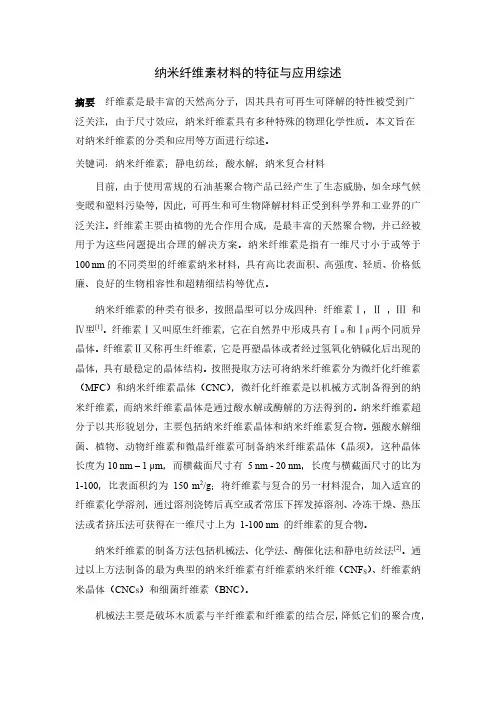
纳米纤维素材料的特征与应用综述摘要纤维素是最丰富的天然高分子,因其具有可再生可降解的特性被受到广泛关注,由于尺寸效应,纳米纤维素具有多种特殊的物理化学性质。
本文旨在对纳米纤维素的分类和应用等方面进行综述。
关键词:纳米纤维素;静电纺丝;酸水解;纳米复合材料目前,由于使用常规的石油基聚合物产品已经产生了生态威胁,如全球气候变暖和塑料污染等,因此,可再生和可生物降解材料正受到科学界和工业界的广泛关注。
纤维素主要由植物的光合作用合成,是最丰富的天然聚合物,并已经被用于为这些问题提出合理的解决方案。
纳米纤维素是指有一维尺寸小于或等于100 nm的不同类型的纤维素纳米材料,具有高比表面积、高强度、轻质、价格低廉、良好的生物相容性和超精细结构等优点。
纳米纤维素的种类有很多,按照晶型可以分成四种:纤维素Ⅰ,Ⅱ,Ⅲ和Ⅳ型[1]。
纤维素Ⅰ又叫原生纤维素,它在自然界中形成具有Ⅰα和Ⅰβ两个同质异晶体。
纤维素Ⅱ又称再生纤维素,它是再塑晶体或者经过氢氧化钠碱化后出现的晶体,具有最稳定的晶体结构。
按照提取方法可将纳米纤维素分为微纤化纤维素(MFC)和纳米纤维素晶体(CNC),微纤化纤维素是以机械方式制备得到的纳米纤维素,而纳米纤维素晶体是通过酸水解或酶解的方法得到的。
纳米纤维素超分子以其形貌划分,主要包括纳米纤维素晶体和纳米纤维素复合物。
强酸水解细菌、植物、动物纤维素和微晶纤维素可制备纳米纤维素晶体(晶须),这种晶体长度为10 nm – 1 μm,而横截面尺寸有 5 nm - 20 nm,长度与横截面尺寸的比为1-100,比表面积约为150 m2/g;将纤维素与复合的另一材料混合,加入适宜的纤维素化学溶剂,通过溶剂浇铸后真空或者常压下挥发掉溶剂、冷冻干燥、热压法或者挤压法可获得在一维尺寸上为1-100 nm 的纤维素的复合物。
纳米纤维素的制备方法包括机械法、化学法、酶催化法和静电纺丝法[2]。
通过以上方法制备的最为典型的纳米纤维素有纤维素纳米纤维(CNF S)、纤维素纳米晶体(CNC S)和细菌纤维素(BNC)。
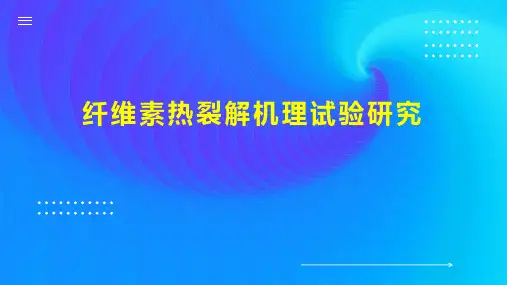
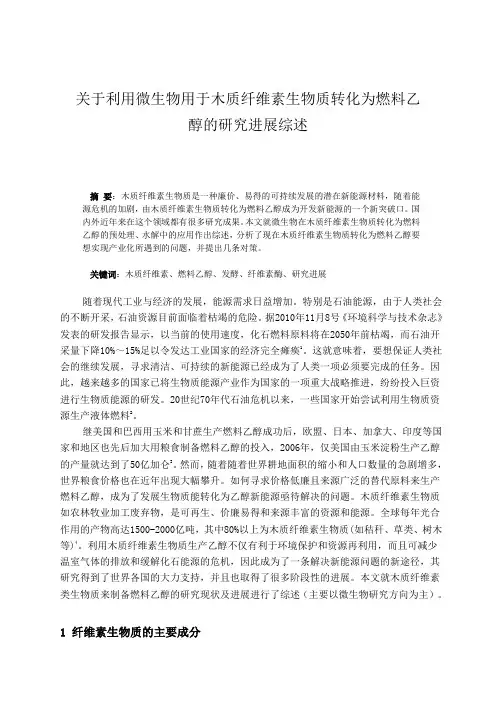
关于利用微生物用于木质纤维素生物质转化为燃料乙醇的研究进展综述摘要:木质纤维素生物质是一种廉价、易得的可持续发展的潜在新能源材料,随着能源危机的加剧,由木质纤维素生物质转化为燃料乙醇成为开发新能源的一个新突破口。
国内外近年来在这个领域都有很多研究成果。
本文就微生物在木质纤维素生物质转化为燃料乙醇的预处理、水解中的应用作出综述,分析了现在木质纤维素生物质转化为燃料乙醇要想实现产业化所遇到的问题,并提出几条对策。
关键词:木质纤维素、燃料乙醇、发酵、纤维素酶、研究进展随着现代工业与经济的发展,能源需求日益增加。
特别是石油能源,由于人类社会的不断开采,石油资源目前面临着枯竭的危险。
据2010年11月8号《环境科学与技术杂志》发表的研发报告显示,以当前的使用速度,化石燃料原料将在2050年前枯竭,而石油开采量下降10%~15%足以令发达工业国家的经济完全瘫痪1。
这就意味着,要想保证人类社会的继续发展,寻求清洁、可持续的新能源已经成为了人类一项必须要完成的任务。
因此,越来越多的国家已将生物质能源产业作为国家的一项重大战略推进,纷纷投入巨资进行生物质能源的研发。
20世纪70年代石油危机以来,一些国家开始尝试利用生物质资源生产液体燃料2。
继美国和巴西用玉米和甘蔗生产燃料乙醇成功后,欧盟、日本、加拿大、印度等国家和地区也先后加大用粮食制备燃料乙醇的投入,2006年,仅美国由玉米淀粉生产乙醇的产量就达到了50亿加仑3。
然而,随着随着世界耕地面积的缩小和人口数量的急剧增多,世界粮食价格也在近年出现大幅攀升。
如何寻求价格低廉且来源广泛的替代原料来生产燃料乙醇,成为了发展生物质能转化为乙醇新能源亟待解决的问题。
木质纤维素生物质如农林牧业加工废弃物,是可再生、价廉易得和来源丰富的资源和能源。
全球每年光合作用的产物高达1500-2000亿吨,其中80%以上为木质纤维素生物质(如秸秆、草类、树木等)4。
利用木质纤维素生物质生产乙醇不仅有利于环境保护和资源再利用,而且可减少温室气体的排放和缓解化石能源的危机,因此成为了一条解决新能源问题的新途径,其研究得到了世界各国的大力支持,并且也取得了很多阶段性的进展。

纤维素酶的结构与功能综述纤维素酶是一类能够降解纤维素的酶,由微生物、真菌和一些动物体内产生,并广泛应用于生物质转化和生物能源生产等领域。
纤维素是植物细胞壁的主要成分之一,由纤维素链通过3-1,4-β-葡聚糖键连接而成,其高度结晶和抗酶解性质使其难以被降解。
纤维素酶通过裂解纤维素链将其转化为可利用的小分子糖类,具有重要的经济和环境意义。
纤维素酶主要包括纤维素酶和β-葡聚糖酶两类酶。
纤维素酶主要作用于纤维素链的内部连接键,将其裂解为较短的纤维素链和纤维素微颗粒,如内切酵素和聚合酶等。
β-葡聚糖酶主要作用于纤维素链的末端葡糖单元,将其裂解为终末葡糖和低聚糖,如终端酶和糖苷水解酶等。
两类酶在纤维素降解中协同作用,形成纤维素降解的完整酶系统。
纤维素酶的结构与功能密切相关。
纤维素酶具有复杂而多样的结构,通常由一个或多个结构域组成,包括纤维素结合结构域、催化结构域和辅助结构域等。
纤维素结合结构域具有特定的结构和纤维素结合能力,使酶能够与纤维素进行特异性的结合。
催化结构域则可将纤维素链裂解为较短的纤维素链。
辅助结构域可与其他酶或辅酶相互作用,增强纤维素酶的活性和稳定性。
此外,纤维素酶还可以通过基因工程技术进行改造和优化,以提高其酶活和抗抑制物能力。
纤维素酶的功能主要体现在纤维素的降解和生物能源生产中。
纤维素酶通过裂解纤维素链,将其转化为可利用的糖类供能源和化学品生产,如生物乙醇、生物丁醇和生物丙酮等。
纤维素酶广泛应用于生物质转化、生物酿造、纸浆生产和饲料添加等领域,可提高资源利用效率和环境可持续性。
此外,纤维素酶还具有重要的应用前景,如抗抑制物能力的改进、多种纤维素酶混合体系的构建和高效纤维素酶的发现等。
综上所述,纤维素酶是一类重要的酶,具有复杂而多样的结构和功能。
纤维素酶通过裂解纤维素链,将其转化为可利用的糖类供能源和化学品生产,具有重要的经济和环境意义。
纤维素酶的结构与功能研究为其改造和优化提供了理论和实践基础,具有重要的应用前景。

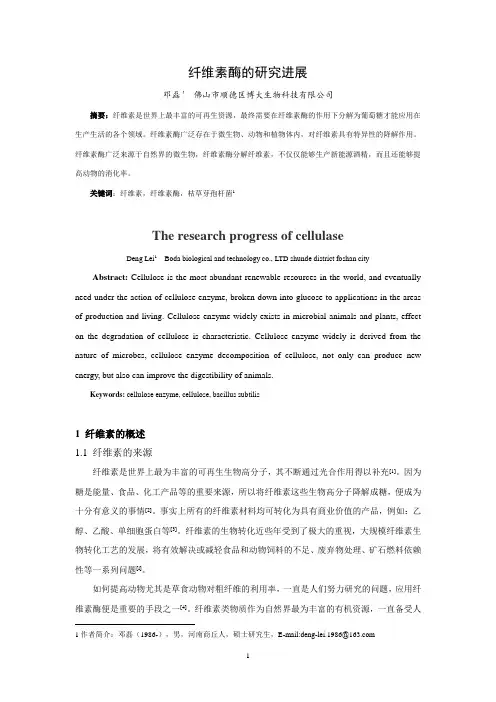
纤维素酶的研究进展邓磊1佛山市顺德区博大生物科技有限公司摘要:纤维素是世界上最丰富的可再生资源,最终需要在纤维素酶的作用下分解为葡萄糖才能应用在生产生活的各个领域。
纤维素酶广泛存在于微生物、动物和植物体内,对纤维素具有特异性的降解作用。
纤维素酶广泛来源于自然界的微生物,纤维素酶分解纤维素,不仅仅能够生产新能源酒精,而且还能够提高动物的消化率。
关键词:纤维素,纤维素酶,枯草芽孢杆菌1The research progress of cellulaseDeng Lei1Boda biological and technology co., LTD shunde district foshan city Abstract: Cellulose is the most abundant renewable resources in the world, and eventually need under the action of cellulose enzyme, broken down into glucose to applications in the areas of production and living. Cellulose enzyme widely exists in microbial animals and plants, effect on the degradation of cellulose is characteristic. Cellulose enzyme widely is derived from the nature of microbes, cellulose enzyme decomposition of cellulose, not only can produce new energy, but also can improve the digestibility of animals.Keywords: cellulose enzyme, cellulose, bacillus subtilis1 纤维素的概述1.1 纤维素的来源纤维素是世界上最为丰富的可再生生物高分子,其不断通过光合作用得以补充[1]。
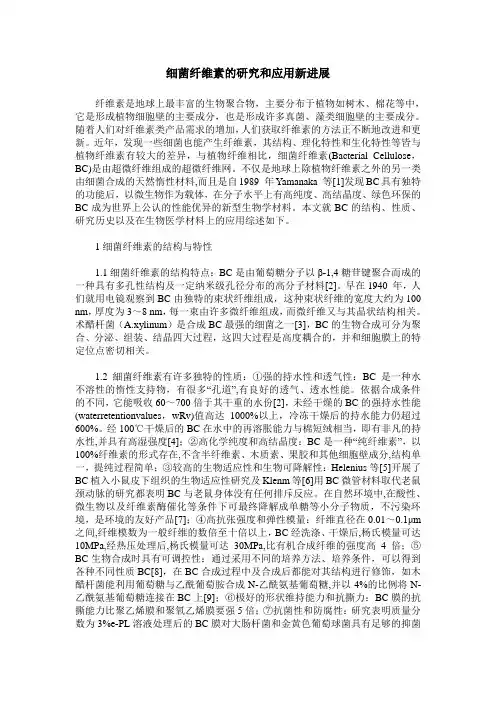
细菌纤维素的研究和应用新进展纤维素是地球上最丰富的生物聚合物,主要分布于植物如树木、棉花等中,它是形成植物细胞壁的主要成分,也是形成许多真菌、藻类细胞壁的主要成分。
随着人们对纤维素类产品需求的增加,人们获取纤维素的方法正不断地改进和更新。
近年,发现一些细菌也能产生纤维素,其结构、理化特性和生化特性等皆与植物纤维素有较大的差异,与植物纤维相比,细菌纤维素(Bacterial Cellulose,BC)是由超微纤维组成的超微纤维网。
不仅是地球上除植物纤维素之外的另一类由细菌合成的天然惰性材料,而且是自1989 年Yamanaka 等[1]发现BC具有独特的功能后,以微生物作为载体,在分子水平上有高纯度、高结晶度、绿色环保的BC成为世界上公认的性能优异的新型生物学材料。
本文就BC的结构、性质、研究历史以及在生物医学材料上的应用综述如下。
1细菌纤维素的结构与特性1.1细菌纤维素的结构特点:BC是由葡萄糖分子以β-1,4糖苷键聚合而成的一种具有多孔性结构及一定纳米级孔径分布的高分子材料[2]。
早在1940 年,人们就用电镜观察到BC由独特的束状纤维组成,这种束状纤维的宽度大约为100 nm,厚度为3~8 nm,每一束由许多微纤维组成,而微纤维又与其晶状结构相关。
术醋杆菌(A.xylinum)是合成BC最强的细菌之一[3],BC的生物合成可分为聚合、分泌、组装、结晶四大过程,这四大过程是高度耦合的,并和细胞膜上的特定位点密切相关。
1.2 細菌纤维素有许多独特的性质:①强的持水性和透气性:BC是一种水不溶性的惰性支持物,有很多“孔道”,有良好的透气、透水性能。
依据合成条件的不同,它能吸收60~700倍于其干重的水份[2],未经干燥的BC的强持水性能(waterretentionvalues,wRv)值高达1000%以上,冷冻干燥后的持水能力仍超过600%。
经100℃干燥后的BC在水中的再溶胀能力与棉短绒相当,即有非凡的持水性,并具有高湿强度[4];②高化学纯度和高结晶度:BC是一种“纯纤维素”,以100%纤维素的形式存在,不含半纤维素、木质素、果胶和其他细胞壁成分,结构单一,提纯过程简单;③较高的生物适应性和生物可降解性:Helenius等[5]开展了BC植入小鼠皮下组织的生物适应性研究及Klenm等[6]用BC微管材料取代老鼠颈动脉的研究都表明BC与老鼠身体没有任何排斥反应。
Toward an Aggregated Understanding of Enzymatic Hydrolysis of Cellulose:Noncomplexed Cellulase SystemsYi-Heng Percival Zhang,1Lee R.Lynd 1,21Thayer School of Engineering,Dartmouth College,Hanover,New Hampshire 03755;e-mail:percival.zhang @,Lee.R.Lynd @ 2Department of Biological Sciences,Dartmouth College,Hanover,New Hampshire 03755Received 2June 2004;accepted 29July 2004Published online 10November 2004in Wiley InterScience ().DOI:10.1002/bit.20282Abstract:Information pertaining to enzymatic hydrolysis of cellulose by noncomplexed cellulase enzyme systems is reviewed with a particular emphasis on development of aggregated understanding incorporating substrate features in addition to concentration and multiple cellulase compo-nents.Topics considered include properties of cellulose,adsorption,cellulose hydrolysis,and quantitative models.A classification scheme is proposed for quantitative models for enzymatic hydrolysis of cellulose based on the number of solubilizing activities and substrate state variables in-cluded.We suggest that it is timely to revisit and reinvig-orate functional modeling of cellulose hydrolysis,and that this would be highly beneficial if not necessary in order to bring to bear the large volume of information available on cellulase components on the primary applications that motivate interest in the subject.B 2004Wiley Periodicals,Inc.Keywords:adsorption;cellulose;cellulase;hydrolysis;ki-netic modelINTRODUCTIONThe potential importance of cellulose hydrolysis in the con-text of conversion of plant biomass to fuels and chemicals is widely recognized (Lynd et al.,1991,1999;Himmel et al.,1999),and cellulose hydrolysis also represents one of the largest material flows in the global carbon cycle (Falkowski et al.,2000).The quantity of scientific information on components of cellulose-hydrolyzing enzyme system has expanded dramatically in recent years.Over the 12-year period from 1991to 2003,for example,the number of known glycosyl hydrolases gene sequences has increased from f 300to >10,000,and the number of cellulase crystal structures has increased from several to f 230(H.Henrissat,mun.).Also during this period,exten-sive structurally based classification schemes have been introduced for both catalytic and cellulose-binding mod-ules,and have led to new insights and hypotheses with respect to the evolution of cellulase systems (Henrissat,1991;Henrissat and Bairoch,1993,1996),updated fre-quently at http//:rs.mrs.fr/CAZY.In order for the large volume of available information on cellulase components to be brought to bear on the primary applications that motivate interest in cellulose hydrolysis,e.g.,conversion of renewably produced biomass to fuels and commodity chemicals,it is necessary to incorporate this information into an understanding of cellulase systems comprised of multiple components with distinct modes of action.The situation is further complicated because the action of cellulase enzyme systems is impacted by substrate properties in addition to concentration—such as degree of polymerization,crystallinity,accessible area,the presence of lignin—which depend on the particular substrate being investigated and change as the reaction proceeds.In the course of seeking an ‘‘aggregated’’understanding of enzy-matic hydrolysis of cellulose that incorporates informa-tion about cellulase components and substrate features in addition to concentration,quantitative models are tremen-dously valuable.Of particular importance,measured pa-rameters for cellulase components and substrates could in principle be incorporated into models used to predict the behavior of multicomponent cellulase enzyme parison of such predictions to experimental measure-ments is the most systematic and rigorous means available by which to test whether understanding of cellulase compo-nents and their interactions is sufficient to explain a given observation.In addition,once a quantitative model is vali-dated,it can be used to rapidly formulate new hypotheses of significance in both fundamental and applied contexts.B 2004Wiley Periodicals,Inc.Correspondence to:Y.-H.P.Zhang or L.R.LyndContract grant sponsors:Department of Energy and National Institute of Standards and TechnologyContract grant numbers:DE-FG02-02ER15350and 60NANB1D0064REVIEWThis article reviews available information on enzymatic hydrolysis by noncomplexed cellulase systems;that is,sys-tems based on components that act discretely rather than as stable complexes(Lamed et al.,1983;Tomme et al., 1995a).A considerable portion of this review is spent on the properties of cellulose in light of the central role such properties play in mechanistically based quantitative models of cellulose hydrolysis.In particular,the following section considers crystallinity,degree of polymerization, accessibility,preparation and properties of model sub-strates,and pretreated lignocellulosic materials.The section Cellulase Adsorption is devoted to adsorption leading to the formation of cellulose–cellulase complexes,including ad-sorption models,reversibility,and enzyme mobility,as well as inferred accessibility of cellulose from cellulase adsorp-tion.Thereafter,mechanistic understanding of cellulose hydrolysis by noncomplexed systems is addressed in Cellulose Hydrolysis,with attention given to concep-tual understanding of cellulose hydrolysis,features of the widely studied Trichoderma reesei cellulase system,docu-mentation and understanding of synergism among cellu-lase components,and a summary of current mechanistic understanding.The section Quantitative Models presents a classification scheme and summarizes features of mod-els reported in the literature.The final section offers con-cluding perspectives and outlines outstanding challenges associated with understanding and modeling noncomplexed cellulase systems.Since our primary focus is on the function of cellulases rather than their structure,we use the older, functionally defined nomenclature rather than the newer nomenclature based on amino-acid sequence and molecu-lar structure.CELLULOSEAll cellulose is produced biosynthetically.While cellulose production by photosynthetic higher plants and algae is thought to be by far the most important in terms of global carbon flows,cellulose production by nonphotosynthetic organisms(certain bacteria,marine invertebrates,fungi, slime molds and amoebae)has also been documented (Coughlan,1985;Jarvis,2003;Lynd et al.,2002;Tomme et al.,1995a).Cellulose is a linear condensation polymer consisting of D-anhydroglucopyranose joined together by h-1,4-glycosidic bonds.Anhydrocellobiose is the repeating unit of cellulose,since adjacent anhydroglucose mole-cules are rotated180j with respect to their neighbors (Fig.1a).This rotation causes cellulose to be highly sym-metrical,since each side of the chain has an equal number of hydroxyl groups.Coupling of adjacent cellulose mol-ecules by hydrogen bonds and van der Waal’s forces re-sults in a parallel alignment and a crystalline structure. The extensive hydrogen bonds of interchain(2per anhy-droglucopyranose)and intrachain(2f3per anhydrogluco-pyranose)produces straight,stable supramolecular fibers of great tensile strength(Gardner and Blackwell,1974a,b;Krassig,1993;Nevell and Zeronian,1985).In contrast, starch contains amylose and amylopectin connected by a-1,4and to some extent a-1,6glucosidic bonds,forming a tightly coiled helical structure maintained by interchain hydrogen bonds(Buleon et al.,1998;Calvert,1997).Na-tive cellulose,referred to as cellulose I,has two distinct crystallite forms,I a,which is dominant in bacterial and algal cellulose,and I h,which is dominant in higher plants (Atalla and Vanderhart,1984).Native cellulose(cellulose I) can be converted to other crystalline forms(II–IV)by var-ious treatments(Klein and Snodgrass,1993;Krassig,1993; O’Sullivan,1997).Cellulose exist as sheets of glucopyranose rings lying in a plane with successive sheets stacked on top of each other to form a three-dimensional particle.Because of this ar-rangement,the surface of a cellulose particle has distinct ‘‘faces’’that interact with the aqueous environment and cellulase enzymes.The six carbons in the glucopyranose ring and internal h-glucosidic bonds lie in the ab plane or ‘‘110’’face,whereas the ac plane or11¯0face consists of the edges of rings(see Fig.1b).Additional faces present reducing and nonreducing ends,respectively.The repeating unit of the110face is the cellobiose lattice,which mea-sures1.04nm along the axis of the cellulose molecule and 0.54nm in the perpendicular direction.About100cellu-lose glucans are aggregated into elementary fibrils with a crystalline width of4–5nm(O’Sullivan,1997),and bunches of elementary fibrils are embedded in a matrix of hemicellulose with a thickness of7–30nm.The lignifica-tion process occurs late in the process of synthesizing nat-ural fibers,so lignin is located primarily on the exterior of microfibrils where it covalently bonds to hemicellulose (Fig.1c;Klein and Snodgrass,1993).The relationship between structural features of cellu-lose and rates of enzymatic hydrolysis has been the subject of extensive study and several reviews(Converse,1993; Cowling and Kirk,1976;Lynd et al.,2002;Mansfield et al., 1999;McMillian,1994),but is still incompletely under-stood.Structural features of cellulose commonly considered as rate-impacting factors include crystallinity index,degree of polymerization,and accessible area.Crystallinity Index(CrI)Crystallinity has often been thought of as providing an indication of substrate reactivity,and is prominently fea-tured in the model of Wood(1975)as well as other models. The crystallinity of dried cellulose samples can be quan-titatively measured from the wide-range X-ray diffraction pattern(Krassig,1993).In the case of cellulose-I,the crys-tallinity index(CrI)is calculated using the formula:CrI¼1Àh am=h cr¼1Àh am=ðh totÀh amÞð1Þbased on the ratio of the height of crystalline cellulose in the002reflection at2u=22.5j(h cr)to the height of amorphous cellulose(h am),and h tot=h cr+h am.Cotton798BIOTECHNOLOGY AND BIOENGINEERING,VOL.88,NO.7,DECEMBER30,2004(Hoshino et al.,1997;Lee et al.,1982;Sinitsyn et al.,1991), bacterial cellulose from Aacetobacter xylinum(Boisset et al.,1999;Gilkes et al.,1992;Valjamae et al.,1999),and cellulose from the alga Valonia ventricosa(Boisset et al.,1999;Fierobe et al.,2002)provide examples of highly crystalline cellulose,while phosphoric acid swollen cellu-lose and ball-milled cellulose are regarded as amorphous cellulose(Hoshino et al.,1997;Lee et al.,1982;Ooshima Figure1.a:Structure of cellulose featuring repeating h1,4-linked anhydrocellobiose units.b:Cellulose I crystal.The axes of the repeating unit (cellobiose)are:a=0.817nm,b=1.04nm,and c=0.786nm.The faces of the glucopyranose rings are parallel to the ab plane(110face)of the crystal (Mosier et al.,1999).c:Organization of lignocellulose origanization into elementary fibrils and microfibrils(Klein and Snodgrass,1993).ZHANG AND LYND:NONCOMPLEXED CELLULASE SYSTEMS799et al.,1983).Common model substrates derived from bleached commercial wood pulps,such as Avicel(Wood and Bhat,1988;Wood,1988),filter paper(Henrissat et al., 1985),and Solka Floc(Bertrain and Dale,1985;Fan et al., 1980;Lee et al.,1982;Sinitsyn et al.,1991)are regarded as a blend of amorphous and crystalline forms(Gilkes et al., 1991).Typical values of CrI for various model cellulosic substrates are presented in Table I.The CrI value of cel-lulose increases after a period of water swelling due to re-crystallization(Fan et al.,1980;Lee et al.,1983;Fengel and Wegener,1984),and the variations in drying condition prior to measurement of CrI may cause differences between substrates arising from the method of substrate preparation rather than properties of the substrate per se(Lenze et al., 1990;Weimer et al.,1995).The presence of residual cells and proteins can also result in artifacts in the CrI assay (Converse,1993).Cellulose hydrolysis rates mediated by fungal cellulases are typically3–30times faster for amorphous cellulose as compared to high crystalline cellulose(Lynd et al.,2002; Table III).This observation led investigators in the1980s to postulate a model for cellulose structure consisting of amorphous and crystalline fractions(Fan et al.,1980,1981; Lee et al.,1983).If this hypothesis were correct,it would be expected that crystallinity should increase over the course of cellulose hydrolysis as a result of preferential reaction of amorphous cellulose(Betrabet and Paralikar, 1977;Ooshima et al.,1983).However,several studies have found that crystallinity does not increase during enzymatic hydrolysis(Lenze et al.,1990;Ohmine et al.,1983;Puls and Wood,1991;Schurz et al.,1985;Sinitsyn et al.,1989).Con-sidering both the uncertainty of methodologies for mea-suring CrI as well as conflicting results on the change of CrI during hydrolysis,it is difficult to conclude at this time that CrI is a key determinant of the rate of enzymatic hy-drolysis(Lynd et al.,2002;Mansfield et al.,1999). Future studies aimed at developing and applying im-proved methods would be useful to more definitively re-solve the role of CrI in impacting hydrolysis.In interpreting crystallinity data,and indeed data for all cellulose physical properties,care must be taken to distinguish correlation from cause and effect.For example,several treatments that decrease crystallinity also increase surface area,and it has been suggested that the increased hydrolysis rates observed with substrates arising from such treatments may be due to increasing adsorptive capacity rather than substrate reac-tivity(Caulfield and Moore,1974;Howell and Stuck,1975; Lee and Fan,1982).Comparing the hydrolysis rates on various sources of model cellulosic substrates,Fierobe et al. (2002)concluded that accessibility of cellulose is a more important factor than crystallinity index in determining the hydrolysis rate.Degree of PolymerizationThe degree of polymerization(DP)of cellulosic substrates determines the relative abundance of terminal and interior h-glucosidic bonds,and of substrates for exo-acting and endo-acting enzymes,respectively.DP may be defined in terms of the number average DP(DP N),weight average DP (DP W),or DP inferred from viscosity(DP V):DP N¼M nMW glu¼P N i M i P N i=MW gluð2ÞDP W¼M WMW glu¼P N i M2i P N i=MW gluð3ÞDP V¼M VMW glu¼P N i D P N i=MW gluð4Þwhere N i is the number of moles of a given fraction i having molar mass M i,M N is the number-average molecular weight,M w is the weight-average molecular weight,M V is the viscosity-average molecular weight,MW glu is the molecular weight of anhydroglucose(162g/mol),and D is viscosity.Measurement of DP begins with dissolution of cellulose using a technique that does not alter chain length. Several such methods appear satisfactory,including:1) metal complex solutions such as Cuam solution(Klemm et al.,1998)and cupriethylenediamine(Klemen-Leyer et al., 1992,1994,1996);2)forming cellulose derivatives by reacting with organic solvents(Ng and Zeikus,1980)or inorganic acids such as nitric acid(Whitaker,1957);and3) ionic solutions such as N,N-dimethylacetamide(DMAc)/ LiCl(Striegel,1997).After dissolution,DP N can be mea-sured by membrane or vapor pressure osmometry,cry-oscopy,ebullioscopy,determination of reducing end con-centration,or electron microscopy(Krassig,1993).DP W can be measured based on light scattering,sedimentation equilibrium,and X-ray small angle scattering,and DP V is measured based on viscosity.The viscosity of dissolved cellulose or cellulose derivatives has been found to equal:D¼K m M aþ1ið5ÞTable I.Summary of some physical properties of model cellulosicsubstrates.Substrate1CrI2SSA2(m2/g)DP N2F RE(%)Avicel0.5–0.6203000.33BC0.76–0.9520020000.05PASC0–0.04240100 1.0Cotton0.81–0.95na.1000–30000.1–0.033Filter Paper–0.45na.7500.13Wood pulp0.5–0.761–55500–15000.06–0.21BC,bacterial cellulose;PASC,phosphoric acid swollen cellulose;CrIdenotes crystallinity index;SSA denotes specific surface area by BET;DP N denotes the number-average degree of polymerization;F RE denotesthe fraction of reducing ends.2References in text.800BIOTECHNOLOGY AND BIOENGINEERING,VOL.88,NO.7,DECEMBER30,2004in which K m =constant,with the value of a for cellulose and cellulose derivatives in most cases ranging from 0.75to 1(Krassig,1993).Therefore,DP V can be written as:DP V ¼PN i M 1:75À2i P N i=MW glu ð6ÞSince cellulose is polydisperse,DP W z DP V >DP N .The DP N values are adequate in dealing with cellulose hydrol-ysis,and DP W and DP V frequently show a good correlation to polymer properties (Klemm et al.,1998;Krassig,1993).The distribution of DPs among a population of cellulose molecules can be measured by size exclusion chromatog-raphy (Yau et al.,1979).The reciprocal of DP corresponds to the fraction of reducing ends relative to all glucan units present (F NR ,unitless).Cellulose solubility decreases drastically with increasing DP due to intermolecular hydrogen bonds.Cellodextrins with DP from 2–6are soluble in water (Klemm et al.,1998;Miller,1963;Pereira et al.,1988),while cellodextrins from 7–13or longer are somewhat soluble in hot water (Zhang and Lynd,2003;Schmid et al.,1988).A glucan of DP =30already represents the polymer ‘‘cellulose’’in its structure and properties (Klemm et al.,1998).The DP of cellulosic substrates varies greatly,from <100to >15,000,depending on substrate origin and preparation,as shown in Figure 2.The DP of wood after pulping is reduced to 500–1,500(Bertrain and Dale,1985;Klein and Snodgrass,1993;Lee et al.,1982;Swatloski et al.,2002).After partial acid hydrolysis,the DP of Avicel is further decreased to 130–800(Hoshino et al.,1997;Ng and Zeikus,1980;Ross-Murphy,1985;Steiner et al.,1988;Wood,1985),depending on hydrolysis conditions (Dong et al.,1998)and the DP of the original substrate (Wood,1988).Similarly,the DP of natural cotton can be as high as 15,000,but is reduced to 1,000–3,000or less in the preparation of cotton linters involving treatment to accomplish dewaxing and whitening (Kleman-Leyer et al.,1992,1996;Okazaki and Moo-Young,1978;Ryu and Lee,1982),and filter paper made from cotton pulp has a DP of 500–1,000or higher (Nisizawa,1973;Kongruang et al.,2004).Bacterial cel-lulose (BC)has an average DP of 2,000–3,000(Hestrin,1963;Fierobe et al.,2002;Valjamae et al.,1999),while bacterial microcrystalline cellulose (BMCC)prepared by treatment of BC with acids ranges from 130–1,300,de-pending on hydrolysis conditions (Valjamae et al.,1999).The DP of phosphoric-acid swollen cellulose (PASC)ranges from 30to more than 1,000(Fan et al.,1980;Krassig,1985;Petre et al.,1981;Wood and McCrae,1972),depending on the DP of the starting substrate (Wood,1988;Hoshino et al.,1997),as well as the phosphoric acid incubation time and temperature (Krassig,1993).The change in DP over the course of hydrolysis for cellulosic substrates is determined by the relative propor-tion of exo-and endo-acting activities and cellulose proper-ties.Exoglucanases act on chain ends,and thus decrease DP only incrementally (Kleman-Leyer et al.,1992,1996;Srisodsuk et al.,1998).Endoglucanases act on interior portions of the chain and thus rapidly decrease DP (Kleman-Leyer et al.,1992,1994;Selby,1961;Srisodsuk et al.,1998;Whitaker,1957;Wood and McCrae,1978).Exoglucanase has been found to have a marked preference for substrates with lower DP (Wood,1975),as would be expected given the greater availability of chain ends with decreasing DP.It is well known that endoglucanase activity leads to an increase in chain ends without resulting in appreciable solubilization (Irwin et al.,1993;Kruus et al.,1995;Re-verbel-Leroy et al.,1997).We know of no indication in the literature that the rate of chain end creation by endogluca-nase is impacted by substrate DP.AccessibilityCellulase enzymes must bind to the surface of substrate particles before hydrolysis of insoluble cellulose can take place.The 3D structure of such particles (including micro-structure)in combination with the size and shape of the cellulase enzyme(s)under consideration determine whether h -glucosidic bonds are or are not accessible to enzymatic attack.Cellulosic particles have both external and internal surfaces.In general,the internal surface area of cellulose is 1–2orders higher than the external surface area (Chang et al.,1981),but this is not always the case,for example,in the case of bacterial cellulose.The internal surface area can be measured by small angle X-ray scattering (SAXS),mer-cury porosimetry,water vapor sorption,and size exclusion (Grethlein,1985;Neuman and Walker,1992;Stone etal.,Figure 2.Typical DP values of cellulose and soluble cellodextrins.NC,natural cotton;NW,natural wood;P,pulp;CT,cotton linter;FP,filter paper.ZHANG AND LYND:NONCOMPLEXED CELLULASE SYSTEMS 8011969).The internal surface area of porous cellulose particles depends on the capillary structure and includes intrapar-ticulate pores(1–10nm)as well as interparticulate voids (>5A m)(Marshall and Sixsmith,1974).Grethlein(1985) found linear correlations between the initial hydrolysis rate of pretreated biomass and the pore size accessible to a molecule with a diameter of51A˚,similar to the size of T.reesei cellulase components.But the surface exposed to dextran cannot distinguish the specific active cellulose sur-face area at which enzymatic hydrolysis occurs from the surface area which is not a site for enzymatic attack(Chanzy et al.,1984;Gilkes et al.,1992;Lehtio et al.,2003),re-sulting in potential overestimation of effective cellulase-accessible area.Techniques for measuring internal surface generally do not estimate external area(Converse,1993). External surface area is closely related to shape and par-ticle size,and can be estimated by microscopic observation (Gilkes et al.,1992;Henrissat et al.,1988;Reinikainen et al., 1995b;Weimer et al.,1990;White and Brown,1981).For example,the external surface area of BMCC is f115m2/g (Gilkes et al.,1992)whereas that of Avicel is f0.3m2/g (Weimer et al.,1990).Increasing cellulase adsorption and cellulose reactivity with decreasing particle size has been reported(Kim et al.,1992;Mandels et al.,1971).However, this may be due to causes other than increased external area, perhaps decreasing mass transfer resistance,since external surface is thought to be a small fraction of overall surface area for most substrates.The gross cellulose accessibility is generally measured by the sorption of nitrogen,argon or water vapor,dimensional change or weight gain by swelling in water or organic liquids,and exchange of H to D atoms with D2H.The most widely used procedure for specific surface area(SSA)is the Brunauer-Emmett-Teller(BET)method using nitrogen adsorption.Due to variations in the experimental condi-tions such as adsorption time,vacuum time and vacuum pressure(Marshall and Sixsmith,1974),sample prepara-tion(Grethlein,1985;Lee et al.,1983),and sample origin and features(Marshall and Sixsmith,1974;Weimer et al., 1990),a wide range of gross area values have been reported in the literature even for the same substrate.The specific area of Avicel PH102increases from5.4m2/g surface area to18m2/g after a long time of water swelling,because the capillary structure of air-dried cellulose from the water-swollen state collapses,resulting in drastic changes in phys-ical parameters(Grethlein,1985;Lee et al.,1983).To keep substrate capillary structure as it exists in the hydrated state,it is recommended that SSA be measured using solvent-dried samples(Grethlein,1985;Lee et al.,1983). The typical SSA of BMCC,Avicel,and wet pulp are f200m2/g BMCC(Bothwell et al.,1997),1.8–22m2/g Avicel(Fan et al.,1980;Lee et al.,1983;Marshall and Sixsmith,1974),and55–61m2/g pulp(Fan et al.,1980; Kyriacou et al.,1988).The specific surface area of PASC from Solka Floc increases from19.5to239m2/g when phosphoric acid concentration increases from75%to85% (Lee et al.,1982).Because a nitrogen molecule is much smaller than cellulase,it has access to pores and cavities on the fiber surface that cellulase cannot enter.Therefore, there is limited basis to infer that SSA measured using the BET method is a key determinant of enzymatic hydrolysis rate(Mansfield et al.,1999).Preparation and Properties of Model Substrates Wood pulp is made from wood using several steps,in-cluding shredding,delignification,bleaching,and washing (Klemm et al.,1998).For example,Solka Floc is made from SO2-bleached spruce pulp by ball milling(Ghose, 1969).Avicel,also called hydrocellulose and microcrystal-line cellulose,is prepared from cellulosic fibers(wood pulp) by partial acid hydrolysis and then spray drying of the washed pulp slurry,but microcystalline cellulose(Avicel) still contains a substantial amount(f30–50%)of amor-phous cellulose(Krassig,1993).Bacterial cellulose(BC) is prepared from the pellicle produced by Acetobacter xylinum(ATCC23769)(Hestrin,1963)or from Nata de Coco(Daiwa Fine Produces,Singapore;Boisset et al., 2000).Bacterial microcrystalline cellulose(BMCC)is pre-pared from BC by partial acid hydrolysis to remove amor-phous cellulose(Valjamae et al.,1999).Cotton cellulose is made from natural cotton after removing impurities such as wax,pectin,and colored matter(Corbett,1963). Whatman No.1filter paper is made from cotton pulp (Dong et al.,1998).Homogenous amorphous cellulose can be made from various pure cellulose powders,e.g.,Avicel, cotton linters,by swelling treatments such as phosphoric acid,alkali,DMSO,DMAc/LiCl.Phosphoric acid swol-len cellulose(PASC)is most commonly made by swelling cellulose powder using concentrated phosphoric acid,re-sulting in decreased crystallinity(Wood,1988).Typical values for CrI,DP,gross surface area values(SSA by BET), and fraction of reducing ends(F NR,reciprocal of DP)for model cellulosic substrates are presented in Table I. Characteristics of Pretreated LignocelluloseNatural cellulose molecules occur in elementary fibrils closely associated with hemicellulose and other structural polysaccharides as well as lignin(Fig.1c).Such ligno-cellulose typically contains cellulose(35–50wt.%),hemi-cellulose(20–35wt.%),and lignin(5–30wt.%)(Chang et al.,1981;Klein and Snodgrass,1993;Lynd et al.,2002; Mansfield et al.,1999).A detailed consideration of en-zymatic hydrolysis of native lignocellulose may be found elsewhere(Hatfield et al.,1999).Since enzymatic hydro-lysis of native lignocellulose usually results in solubiliza-tion of V20%of the originally present glucan,some form of pretreatment to increase amenability to enzymatic hy-drolysis is included in most process concepts for biological conversion of lignocellulose.Pretreatment,under appro-priate conditions,retains nearly all of the cellulose pres-ent in the original material and allows close to theoretical yields upon enzymatic hydrolysis.Proposed pretreatment802BIOTECHNOLOGY AND BIOENGINEERING,VOL.88,NO.7,DECEMBER30,2004processes include dilute acid,steam explosion at high solid concentration,‘‘hydrothermal’’process,‘‘organosolv’’pro-cesses involving organic acid solvents in an aqueous phase, ammonia fiber explosion(AFEX),strong alkali process (Lynd et al.,2002),as well as mechanical treatments such as hammer and ball milling(Millett et al.,1976;Sun and Cheng,2002).Comparative features of these processes as well as consideration of substrate factors impacting the hy-drolysis rate are reviewed elsewhere(Chang et al.,1981; Converse,1993;Cowling and Kirk,1976;Dale,1985;Hsu, 1996;Ladisch et al.,1983;Mansfield et al.,1999;McMillian 1994;Lynd,1996;Sun and Cheng,2002;Weil et al.,1994; Wood and Saddler,1988).Hydrolysis of lignocellulosic biomass is more compli-cated than that of pure cellulose due to the presence of nonglucan components such as lignin and hemicellulose. Lignin removal and/or redistribution are thought to have a significant effect on observed rates of enzymatic hydrolysis (Chernoglazov et al.,1988;Converse,1993;Lynd et al., 2002).Lignin has been implicated as a competitive cel-lulase adsorbent which reduces the amount of cellulase available to catalyze cellulose hydrolysis(Bernardez et al., 1993;Ooshima et al.,1990;Sutcliffe and Saddler,1986). In addition,it has been suggested that residual lignin blocks the progress of cellulase down the cellulose chain(Eriksson et al.,2002;Mansfield et al.,1999).The measured crystallinity index of lignocellulose is impacted by the presence of lignin and hemicellulose.Thus, care must be taken in comparing CrI values for lignocellu-losic substrates to values for cellulosic substrates,and also in comparing the CrI of lignocellulosic substrates before and after pretreatment.Reported CrI values for pretreated materials are generally in the range of0.4–0.7(Chang and Holtzapple,2000;Gharpuray et al.,1983;Koullas et al., 1992;Sinitsyn et al.,1989,1991).Pretreatment by either dilute-acid or steam explosion under conditions that are quite effective in enhancing hydrolysis has been found to increase the composite CrI of lignocellulose(Deschamps et al.,1996;Kim et al.,2003;Knappert et al.,1980; Meunier-Goddik et al.,1999).Consistent with this,a negative correlation between hydrolysis rate and CrI has been shown in experiments that involved chemical pre-treatments followed by ball milling(Chang and Holtzapple, 2000;Gharpuray et al.,1983;Knappert et al.,1980;Koullas et al.,1992;Sinitsyn et al.,1989,1991),and also ex-periments that examined various pretreatment conditions (Chang and Holtzapple,2000).In contrast to the trend ob-served for other pretreatment processes,AFEX pretreat-ment has been reported to result in a decrease in CrI (Gollapalli et al.,2002).Several investigators have impli-cated accessible surface area as an important factor in determining the effectiveness of pretreatment(Gharpuray et al.,1983;Grethlein,1985;Grethlein and Converse,1991; Sinitsyn et al.,1991).A significant difficulty in interpreting the effects of pretreatment at a mechanistic level is that exposure of substrates to conditions that cause one poten-tial determinant of reactivity to change usually bring about changes in other such potential determinants.For example, Sinitsyn et al.(1991)found a strong negative correlation between CrI and accessible surface area accompanying several pretreatment processes.We suspect that the impact of increased surface area accompanying pretreatment may in many cases be more important than changes in CrI,al-though further work will be needed to establish this point and the relative significance of these and other factors may well be different for different processes.DP values of lignocellulosic substrates such as ba-gasse,wheat straw,and Eucalyptus regnans pretreated using steam explosion,supercritical CO2,alkali,and ozone mostly fall in the range of600–1,100,although values as high as3,000have been recorded for Pinus radiata chips (Puri,1984;Sinitsyn et al.,1991).During dilute acid-catalyzed cellulose hydrolysis,the DP of cellulosic ma-terials decreases rapidly initially and achieves a nearly constant value thereafter called the level-off DP(LODP) (Klemm et al.,1998;Krassig,1993;Wood,1988).LODP values in the range of100–300have been measured,de-pending on the substrate and conditions such as temperature and acid concentration(Krassig,1993;Wood,1988).This LODP value may limit the rates of hydrolysis that can oc-cur with dilute acid pretreated lignocellulose,although this has not been investigated experimentally.Different con-clusions about the importance of DP in determining hydrolysis rates of pretreated cellulosic biomass have been drawn,with Sinitsyn et al.(1991)concluding that DP is relatively unimportant,but Puri(1984)concluding that it is quite important.CELLULASE ADSORPTIONAdsorptionCellulase adsorption is rapid compared to the time re-quired for hydrolysis,with many studies finding that ad-sorption reaches steady-state within half an hour(Lynd et al.,2002).The most common description of cellulase adsorption is the Langmuir isotherm(Eq.[7]),derived as-suming that adsorption can be described by a single ad-sorption equilibrium constant and a specified adsorption capacity.The Langmuir isotherm may be represented as:E a¼W max K P E f1þK P E fð7Þin which E a is adsorbed cellulase(mg or A mol cellulase/L), W max is the maximum cellulase adsorption=A max*S(mg or A mol cellulase/L),A max is the maximum cellulase adsorp-tion per g cellulose(mg or A mol cellulase/g cellulose),S is cellulose concentration(g cellulose/L),E f is free cellulase (mg or A mol cellulase/L),and K P is the dissociation constant (K P¼E a f)in terms of L/g cellulose.The distribution coef-ficient or partition coefficient,R,is defined as:R¼K P W maxð8ÞZHANG AND LYND:NONCOMPLEXED CELLULASE SYSTEMS803。
收稿日期 Received: 2013-04-03 接受日期 Accepted: 2013-05-13*四川省科技支撑计划项目(2009NZ00045)资助 Supported by the Key Technology R & D Program of Sichuan, China (2009NZ00045)**通讯作者 Corresponding author (E-mail: hemxion@)纤维素类草本能源植物的研究现状*谭芙蓉1 吴 波1 代立春1 祝其丽1 王文国1 汤晓玉1 潘 科1 秦 晗1胡启春1, 2 何明雄1, 2**1农业部沼气科学研究所生物质能技术研究中心 成都 6100412农业部农村可再生能源开发与利用重点实验室 成都 610041要 纤维素类草本能源植物具有很高的生物质产量、纤维素和半纤维素含量,对环境友好,是目前最有发展前途的生物质资源之一,欧洲和美国将其作为首选的生物质能源植物. 本文介绍了柳枝稷(Panicum virgatum )、芒草(Miscanthus spp.)、芦竹(Arundo donax Linn )等几种主要纤维素类草本能源植物具有产量高、适应性强、用途广泛等特点;综述了纤维素类草本能源植物在国内外的研究概况,以及基因工程技术在降低植物木质素含量及在植物中过表达纤维素降解酶类方面的应用;进一步指出在我国存在纤维素类草本能 源植物资源评估、选育滞后,相关技术还不完善等问题,进行充分开发利用将在缓解能源紧张、解决环境问题、促进农业和经济发展等方面有着良好的前景. 图2 表1 参41关键词 纤维素;草本能源植物;遗传改良;基因工程;燃料乙醇CLC S216.2Research and prospect of cellulosic herbaceous energy plant *TAN Furong 1, W U Bo 1, DAI Lichun 1, ZHU Qili 1, WANG Wenguo 1, TANG Xiaoyu 1, PAN Ke 1, QIN Han 1, HU Qichun 1, 2 & HE Mingxiong 1, 2**1 Biomass Energy Technology Research Centre, Biogas Institute of Ministry of Agriculture , Chengdu 610041, China 2Key Laboratory of Energy Microbiology and Application, Ministry of Agriculture , Chengdu 610041, ChinaCellulosic herbaceous energy plant, which has high biomass yield, cellulose and hemicellulose content, is one of the most promising biomass resources positively in fl uencing the environment. It has been used as a preferred biomass energy plant in Europe and the United States. This paper introduces the characteristics of high yield, well-adapted and wide application of some main herbaceous energy plants, such as switchgrass, miscanthus and bamboo reed. It also summarizes the research status of cellulosic herbaceous energy plant and application of genetic engineering technology on decreasing lignin content and overexpression cellulase in plants. This article further presents the problems, such as resource evaluation, lagging of breeding and imperfect technology, and prospects of developing celluslosic herbaceous energy plant in China. If the abundant resource of herbaceous energy plant of our country could be ef fi ciently utilized, it can not only alleviate nergy crisis, but also make full use of the barren land, change planting structure, increase farmers’ income, and in the long run promote the national economy. Keywords cellulose; herbaceous energy plant; genetic improvement; genetic engineering; fuel ethanol当前矿物能源短缺和全球气候变暖是世界各国所面临的严峻问题,开发利用不会对环境带来危害的可再生能源资源成为当今国际社会的主要课题之一. 生物质资源是最具开发潜力的可再生清洁能源资源[1],其开发利用已被我国政府列为《国家中长期科学和技术发展规划纲要(2006-2020)》中的优先发展主题. 2007年中央一号文件明确指出,以生物能源、生物基产品和生物质原料为主要内容的生物质产业,是拓展农业功能、促进资源高效利用的朝阳产业,并鼓励有条件的地方利用荒山、荒地等资源,发展生物质原料作物种植. 因此,从可持续性发展的角度考虑,开发能源植物是解决能源危机 和环境问题的必然趋势. 能源植物作为一个崭新的科学方向正在飞速发展,尤其在欧美发达国家经过20多年的研究,其概念、分类及相应的主要转化利用途径已逐渐明晰.能源植物通常是指那些合成较高还原性烃能力、可产生接近石油成分和替代石油使用的产品的植物,以及富含油脂的植物,是可再生能源开发的唯一资源对象. 能源植物通过光合作用固定二氧化碳和水,将太阳能以化学能形式储藏在植物中. 能源植物除直接燃烧产生热能外,还可转化成固态、液态和气态燃料. 按照能源植物所含有的特定化学物质,将其分为3类:(1)富含类似石油成分的能源植物. 石油的主要成分是烃类,富含烃类的植物是植物能源的最佳来源,生产成本低,利用率高,如续随子(Euphorbia lathylris )、绿玉树(Euphorbia tirucalli )、橡胶树(Hevea brasilienisis )、麻疯树(Jatropha curcas )、桉树(Eucalyptus )、黄连木(Pistacia16320卷 谭芙蓉等/ Chin J Appl Environ Biol 应用与环境生物学报chin e nsis Bunge )等[2]. (2)富含高糖、高淀粉和高纤维的能源植物. 用这类植物可以得到最终产品——乙醇. 这类植物种类特别多,分布也比较广泛,如木薯(Manihot esculenta )、甜菜(Beta vulgaris .)、高粱(Sorghum bicolor )、玉米(Zea mays )、柳枝稷(Panicum virgatum )等[3]. (3)富含油脂的能源植物. 据估计,高等植物中有7%左右种类的器官(多为种子)含油率在10%以上,有些含油率很高,如木姜子(Litsea )种仁含油率达55.4%,红脉钓樟(Lindera rubronervia )种子含油率高达44.9% [4]. 在这些能源植物中,富含纤维素的草本能源植物具有生长速度快、生活周期短、分布广等特点,便于大面积推广种植,实现产业化. 草本能源植物是目前最有发展前途的生物质资源之一,欧洲和美国把它作为首选的生物质能源植物[5]. 本文介绍了纤维素类草本能源植物的特点、主要种类、研究概况以及基因工程在纤维素能源植物方面的应用,并对其发展前景进行展望,以期为进一步研究和应用提供参考.1 纤维素类草本能源植物的种类及特点纤维素类能源植物一般为禾本科多年生高大的丛生草本植物,富含纤维素和半纤维素,灰分含量低,热值高,干物质产量高;抗旱、耐瘠薄能力强,适应性广. 表1中重点介绍了几种主要纤维素类草本能源植物,包括柳枝稷(Panicum virgatum )、芒草(Miscanthus spp.)、芦竹(Arundo donax Linn )、荻(Miscanthus sacchari florus )和狼尾草(Pennisetum alopecuroides (L.) Spreng ). 作为生物质能源资源,纤维素草本能源植物有如下优点:(1)生长快,产量高,一次种植,可长期(10年以上)受益,一般每年可出1-2茬草,使加工设备得以充分利用;(2)适应性强,可利用边际土地种植,符合我国“不与人争粮,不与粮争地”的能源发展目标;(3)二氧化碳零排放,不污染环境,有利于形成清洁能源产业;(4)没有核能的危险性以及风能、潮汐能和地热能的局限性;(5)用途广泛:不仅可制备纤维素乙醇,还可以广泛应用于生物质直燃或气化发电厂、气化炉、固化成型和热解等各种生物质能源转化与利用装置;(6)多方面的生态效益和经济效益. 因此,研究开发纤维素类草本能源植物对于缓解能源压力、保护环境和生态、促进我国经济社会可持续发展等具有重要意义.2 纤维素类草本能源植物的研究概况纤维素质原料是地球上最丰富的可再生资源. 富含纤维的草本植物通过生物和化学方法处理后,可以得到乙醇和沼气等高燃烧值的能源,还可以用作造纸原料. 美国能源部早在1984年就启动了“草本能源植物研究计划(HECP )”,开始的研究主要集中于草种的筛选,地点分布在俄亥俄州、印第安纳州和维吉尼亚州. 较晚的2个筛选试验设在大平原地区(爱荷华州和北达科他州)进行. 佛罗里达大学负责象草(Pennisetum purpureum )和甘蔗(Saccharum spp.)的筛选. 试验目的是检测草种的产量潜力、分析生化组成和摸索不同试点的最佳管理措施. 在1985-1989年间从35种草本能源植物中筛选出18种最适合美国种植的纤维类能源禾草[5]. 1990年,表1 主要纤维素类草本能源植物介绍164应用与环境生物学报 Chin J Appl Environ Biol /纤维素类草本能源植物的研究现状 1期HECP 更名为“生物质能给料发展计划项目(BFDP )”. 从1991年起,BFDP 项目被集中投放到了模式植物系统的研究上,将柳枝稷确定为模式植物加以重点研究,以便达到快速应用的目的和示范效应. 1992年,美国能源部又通过BFDP 启动了6个专项课题,以便获得柳枝稷作为能源植物的产量新信息. 研究内容包括:1)柳枝稷不同品种的田间品比试验,以示筛选新的优良品种;2)进行生理学研究以便建立筛选和评价优良品种的指标体系;3)开发组织培养技术以对相关植物进行生物技术改良. 在美国东南部,一些研究工作则集中于象草、狗牙根(Cynodon dactylon )和百喜草(Paspalum natatu )等候选植物上[5].欧洲将草本植物作为生物质能的研究起始于芒属植物(Miscanthus ). 自1989年开始先后启动了“欧洲JOULF 计划”、“欧洲AIR 计划”和“欧洲FAIR 计 划”,在全欧范围内对芒属植物及其杂交种的生物量潜力、生殖、发育、管理实践、收获加工以及杂交育种等方面开展了系统研究. 芒属植物具有很强的生长活力,在延迟收获的情况下可以干燥,进而完成生物质的一次性收获. 20世纪90年代,在欧洲只有一个基因型的芒可被利用,即巨芒草(Miscanthus × giganteus ),它的生产性能完全满足生物质能植物的要求. 但在实际应用中却遇到了建植成本高、越冬性差和遗传基础狭窄的问题. 这就促使人们又开始寻找可以用种子进行建植的低成本的其他草本植物,而且能够适应欧洲各国不同的气候条件. 因此,欧洲人开始了对许多本土草种以及引进草种的研究与筛选工作,得到了17种候选植物,并重点对芦竹(Arundo donax L.)和虉草(Phalaris arundinacea L.)展开了深入研究. 同时,为进一步发展芒,还不断培育能够适应欧洲不同地区和不同环境条件的品种,继续扩展其遗传基础以防止病虫害的蔓延[5].我国作为一个资源大国,纤维素类能源植物资源非常丰富,但早期的研究主要集中在水土保持、造纸原料和动物饲料等方面,由于与作为能源植物的利用目的不同,导致了研究内容和育种目标的不同,在资源收集上也产生了极大的差异. 因此,从严格意义上讲,我国在开展草本植物作为能源植物的研究工作还刚刚起步,远远落后于欧美等国家. 目前的研究主要集中在能源植物种质资源的筛选、品种选育和转化工艺等方面,并取得了一定的成绩. 宁祖林等对8种高大纤维禾草的热值和灰分动态变化进行了研究,结果表明芦竹的干重热值与灰分含量有显著的线性相关,五节芒(Miscanthus floridulus )、芦苇(Phragmites australis )的干重热值与灰分含量呈极显著的线性相关;C3植物类中去灰分热值较高的是芦竹,C4植物类中去灰分热值较高的是芒[12]. 潘一晨等人在辽宁省范围内对几种野生禾本科草类植物的自然种群特征进行了调查,综合分析表明芒和狼尾草具有高的产量,高的净光合速率和生长速度是其高产的生理生态学基础,符合能源禾草的要求[13]. 宗俊勤等人对7种高大禾草的表型特性及生物质成分进行了研究,结果表明芒和荻的干物质年产量、燃烧值、折合标准煤均是所有材料中最高的,而灰分是所有材料中最低的,并指出原产中国的芒属植物是较柳枝稷更适合我国的优良的生物质能源植物[14]. 周强等人的研究结果表明,香根草(Vetiveria zizaniodes )具有很强的光合能力及较快的生长速率,叶片中纤维素和半纤维素含量均较高,能够适应边际性土地种植,是一种潜在的优良木质纤维素能源植物[15]. 何明雄等测定了不同人工湿地植物的纤维素组分和热值,并采用NaOH -酶解工艺研究不同人工湿地植物水解液组分,对在人工湿地技术体系中起重要作用的湿地植物能源化利用潜力进行了系统评估,结果表明人工湿地植物是一种较好的生物质资源,可通过生物质固体成型燃料技术、沼气技术和燃料乙醇技术加以利用,进而建立人工湿地植物生物质资源能源化藕联利用模式[16]. 余醉等测定了草本芦竹主要工业成分及化学组成,并采用稀酸法、稀碱法、高温热水法和酸催化高温热水法预处理芦竹,比较了不同预处理方式对各种糖的产率及预处理产物纤维素酶酶解率的影响,为进一步利用草本芦竹作为能源牧草生产燃料乙醇提供了依据[17]. 阮奇城等以红麻(Hibiscus cannabinus )秸杆为原料,研究了不同预处理方法对红麻纤维质乙醇发酵的影响,为红麻纤维质转化燃料乙醇提供基础依据[18-19]. 李高扬等以生产燃料乙醇等清洁生物质能源为目标,提出以化学成分、生物质产量、生态适应性和热值4项指标来评价能源植物的利用价值,为纤维类能源草新资源的评价和开发提供了参考[20].目前,我国也意识到了利用与开发能源植物的重要性,在有关科研项目指南中设立了相应的项目. 如在《2005年度农业科技成 果转化资金项目指南》中设计了“农业生物技术产品与生物质利用”专项,并将“生物质等农村新能源新材料技术及产品”列为了重点支持项目. 在《国家中长期科学和发展规划纲要(2006-2020年)》中,将“可再生能源低成本规模化开发利用”作为重点领域及其优先主题. 在2012年国家重点基础研究发展计划(“973计划”)项目中设立了针对草本能源植物的项目“草本能源植物培育及化学催化剂制备先进液体燃料的基础研究”,将重点围绕草本能源植物选择性培育遗传学、生物质水热解聚、解聚产物催化转化制备先进燃料机理与选择性调控等关键科学问题开展多学科交叉与综合研究. 这些项目的启动实施,对于促进生物质能源利用,缓解我国石油短缺,保障国家能源安全和促进我国新农村建设等方面具有重要意义.植物的研究国内外利用木质纤维生产燃料乙醇已有大量研究,有许多成功的实例. 但是所开发的技术一直未能在规模生产中推广应用,究其根本,主要是因为现阶段的技术中还存在着严重制约植物纤维燃料乙醇生产的关键问题(图1)[21-23]:一是木质纤维物质降解为中间物质和去除木质素使纤维素酶能够接近纤维素的预处理过程成本高,前期预处理的投入过大;二是纤维素水解复合酶的价格昂贵,便整个过程成本偏高[24]. 这两个过程的花费共同使得纤维素乙醇的生产成本比玉米淀粉生产乙醇高2-3倍.20世纪90年代中期以来,基因工程技术对全球农业产生了深刻的影响,在棉花(Gossypium spp.)、大豆(Giycine max )、玉米等主要农作物上都得到了很好的应用. 由于人们对自身健康的关注,植物转基因研究在以食用为目的的作物16520卷 谭芙蓉等/ Chin J Appl Environ Biol 应用与环境生物学报上的应用受到了一定的限制,而这却为能源植物的改良提供了新的契机. 目前,人们开始尝试利用植物基因工程的方法来解决植物纤维燃料乙醇生产中的问题.图1 纤维素乙醇生产流程(根据文献[23]整理).Fig. 1 Flowchart of cellulosic ethanol production (adapted from reference [23]).首先,降低植物的木质素含量. 降低木质纤维中的木质素含量、提高纤维素含量有利于降低木质纤维的前处理成本. 通过基因工程改变木质素合成途径(图2)中不同基因的表达来降低木质素的含量、提高纤维素含量已有大量报道. 如在转基因杨树中,下调木质素合成途径中的一个主要酶基因pt4CL1的表达,可使其木质素的含量下降45%,作为补偿的纤维素含量提高了15%,使杨树的纤维素/木质素的比率升高了一倍,而对杨树的生长、发育和生物结构的完整性没有任何明显的影响[25]. Blee 等人报道将烟草(Nicotiana tabacum )木质素单体聚合最终一步的酶(过氧化物酶)转入菜豆,抑制菜豆中其同源酶阳离子过氧化物酶的表达,得到的反义转基因植株对照相比木质素的含量降低40%-50%,而木质素含量的降低对植株的生长发育没有显著的影响[26]. Fu 等人通过转基因技术下调木质素合成途径中的COMT (咖啡酸-O-甲基转移酶)基因,获得了木质素含量下降的转基因柳枝稷,经稀酸预处理后,采用SSF 法发酵,转基因株系比对照的乙醇产量提高38%,而在乙醇产量相同的情况下,转基因材料所用的纤维素酶比对照要少3倍或4倍[27]. 通过转基因植物对木质素生物合成调控的研究主要表现在两个方面:一是木质素合成总量的调节,涉及的酶类依次为PALI (苯丙氨酸解氨酶)、C4H (肉桂酸4-羟基化酶)、4CL (4-香豆酸辅酶A 连接酶)、CAD (肉桂醇脱氢酶)和CCR (香豆酰辅酶A 还原酶),它们表达活性的高低与木质素总量密切相关;二是与木质素单体特异合成相关酶类的调控,主要集中于COMT (咖啡酸-O-甲基转移酶)、CCoAOMT (咖啡酰辅酶A-O-甲基转移酶)和F5H (阿魏酸5羟基化酶),这些酶的表达对木质素含量尤其是木质素单体的特异合成影响较大,决定了各种单体在木质素总量中的比例.其次是在植物中过表达纤维素降解酶类. 由于通过微生物发酵生产纤维素水解酶的成本昂贵,科学家们试图通过基因工程技术在植物中直接产生纤维素水解酶.热稳定的图2 木质素生物合成途径[23].Fig. 2 The lignin biosynthesis pathway [23].166应用与环境生物学报 Chin J Appl Environ Biol /纤维素类草本能源植物的研究现状 1期Acidothermus cellulolyticus 菌的1,4-β-内切葡聚糖酶的催化区域E1已在拟南芥(Arabidopsis thaliana )、番茄(Lycopersicon esculentum )和马铃薯(Solanum tuberosum )中被成功地表达,表达产物主要集中在质外体区域. 这项研究显示了在植物中生产纤维素酶的可能性,尤其是在拟南芥中,酶含量可达植物可溶性蛋白含量的25% [28]. Acidothermus cellulolyticus 菌的1,4-β-内切葡聚糖酶的催化区域E1也被导入到水稻(Oryza sativa )和玉米中,产物组成型表达到质外体区域[29-30]. 在水稻和玉米的叶片中,内切葡聚糖酶E1的含量分别占水稻和玉米叶片总可溶性蛋白含量的4.9%和2.1%;并且E1在叶片中的积累对植物的生长和发育没有明显的危害作用. 当水稻可溶性蛋白的粗提物被加到用氨水-纤维爆破预处理的水稻或玉米秸秆,这两种秸秆中30%和22%的纤维素被分别水解成葡萄糖. Teymouri 等人用最温和的预处理方法处理含Acidothermus cellulolyticus 菌的1,4-β-内切葡聚糖酶的催化区域E1的转基因烟草,内切葡聚糖酶E1的活性在预处理过程中大约有2/3丧失[31]. 由这个试验可以看出,纤维素分解酶在原材料的预处理过程中极易失活. 因此,在植物中过量表达异源纤维素分解酶,最好是先将纤维素酶从植物中粗提或纯化出来,然后再加入到已预处理好的原材料中进行发酵. Oraby 等人将内切葡聚糖酶E1从转基因水稻中粗提出来,冷冻3个月后加入到用温和方法预处理好的水稻和玉米秸秆中,水稻中约有30%的纤维素、玉米中约有22%的纤维素被转化为葡萄糖[32]. Mei 等人将A. cellulolyticu 的耐热内切葡聚糖酶基因转入玉米绿色组织,将酶定向在内质网和线粒体上,获得了成功表达[33]. Jung 等将来自海栖热袍菌(Thermotoga maritima )的β-葡聚糖酶基因转入烟草的胞质和叶绿体中表达,分别达到可溶性蛋白的4.5%和5.8% [34].最后,还可以通过植物基因工程的手段来增加植物的生物量,降低原料成本. 这些包括调控植物生长和光合作用、充分利用生长季节等. Ku 报道将玉米C4途径的磷酸烯醇式丙酮酸羧化酶(PEPC )和丙酮酸磷酸双激酶(PPDK )的基因在各自启动子的控制下同时引入水稻,可使水稻的光合能力提高35%,稻谷产量增加22% [35]. Lieman-Hurwitz 等将蓝藻(Cyanophyta )的一个无机碳转运蛋白基因重组到植物中表达,可使植物的1, 5-二磷酸核酮糖羧化酶/加氧酶的羧化效率显著提高[36],在潮湿的培养条件下使植物的生物量明显提高. Miyagawa 等报道将蓝藻卡尔文循环中RuBisCo 下游的酶景天庚酮糖1,7-磷酸化酶在烟草叶绿体中超量表达,在潮湿的培养条件下可使烟草的光合效率提高,促进植株的生长[37]. Wang 等人通过转基因抑制拟南芥中去氧亥普酸合成酵素(Deoxyhypusine synthase ,DHS )基因的表达,延迟了拟南芥植株的成熟、衰老时间,通过延长叶的光合作用时间跨度,提高了植株根、茎和种子的生物量[38].以上这些研究工作对于提高能源植物的利用效率、降低生物质能的开发成本都起到了积极作用,随着植物结构基因组和功能基因组研究的深入、生物化学与分子生物学的进一步发展,对植物生长、发育、代谢的生理生化过程中相关基因功能及其调控机制不断明确,利用植物基因工程技术在分子基础上设计和优化能源植物将成为今后改良能源植物的重要研究方向.问题我国对能源植物的开发和应用研究起步较晚,与西方发达国家相比还有相当大的差距,且多数研究以木本植物为主[39]. 许多研究,尤其是对草本能源植物的研究还处在开发阶段[40-41],目前还存在许多问题.(1) 对纤维素类草本能源植物资源的评估相对滞后,对它们的种类和分布状况没有进行全面的普查. 我国作为一个资源大国,有许多像柳枝稷、芒、虉草和芦竹这样的能源植物,其中芒、虉草和芦竹在我国就有天然分布,另外还有河八王属、蔗茅属、金茅属、香茅属、菅草属和狼尾草属等生物质产量很高的C4多年生禾草植物,但目前尚缺乏系统的研究利用及开发评价.(2)目前可利用的优良品种不多,很多尚处在自生自灭的野生或半野生状态,未被驯化栽培. 因此还需要筛选或引进优良种,或通过遗传改良手段人工选育优良种.(3)由于我国对能源植物的开发利用刚开始起步,纤维素类草本能源植物的种植规模小且缺乏大面积栽培. 同时,缺乏相关的研究条件和试验基地. 因此我国应扩大草本能源植物的种植面积,建立相应的研究基地,使其向产业化和规模化迈进.(4)目前制备生物能源的相关技术和加工工艺仍不完善. 比如纤维素酶的活性低,价格昂贵,以及半纤维素的戊糖成分的酒精发酵技术等尚不成熟,限制了将纤维素类生物质转化成燃料乙醇等生物能源. 因此,在纤维素的开发利用方面,筛选优良、高效、廉价的纤维素酶并摸索其发酵条件,以降低生产成本,提高其利用率,是纤维素利用的关键因素.5 展 望我国地跨温带、亚热带和热带雨林地区,植物资源十分丰富,为开发能源植物资源提供了得天独厚的条件. 草本纤维素类能源植物是一类值得研究和开发利用的生物质能源植物,目前已在欧美等国加以开展,而在我国还尚未受到重视. 如果在我国也能将此类资源加以充分利用,不仅可以缓解我国能源紧张的问题,还可以充分利用目前尚未利用的荒芜土地,提高土地的利用率,改变农业种植结构,提高农民的经济收入,进而促进国民经济的高效发展. 参考文献 [References]1 Lang A, Kopetz H, Parker A. Australia: biomass energy holds big promise [J]. Nature , 2012, 488: 590-5912 杨世诚. 绿色能源: 植物是明天[J]. 森林与人类, 2000, 5: 11-12 3费世民, 张旭东, 杨灌英, 周金星, 刘福云. 国内外能源植物资源及其开发利用现状[J]. 四川林业科技, 2005, 26 (3): 20-26 [Fei SM, Zhang XD, Yang GY, Zhou JX, Liu FY. On domestic and international situation of energy plant resources and their exploitation [J]. J Sichuan For Sci Technol , 2005, 26 (3): 20-26]4 中国油脂植物编写委员会. 中国油脂植物[M]. 北京: 科学出版社, 19875Lewandowski I, Scurlock J MO, LI Ndvall E, Christou M. The。
纤维素溶解现状研究摘要纤维素是一类重要的天然高分子聚合物,具有广阔的应用前景。
本文综述了纤维素的溶解与再生技术以及纤维素生物质利用技术的新发展。
其中,纤维素的溶解与再生包括传统的NaOH/CS2体系、N-甲基吗啉-N-氧化物(NMMO)溶解体系、氢氧化钠/尿素(NaOH/Urea)水溶液溶解体系、氯化锂/二甲基乙酰胺( LiCl/DMAc)溶解体系以及新型的离子液体溶剂法,综述了各体系溶解与再生纤维素的技术要点与优缺点。
关键词:纤维素、溶解、离子液纤维素是自然界中最为丰富的可再生资源,人类已有长期的应用历史和应用技术,其加工产物在纤维、造纸、膜、涂料、聚合物等方面有广泛的应用。
在各种资源日益短缺的今天,世界各国对环境污染日益关注和重视,充分利用丰富的纤维素资源发展纤维素工业具有深远的意义。
纤维素由多分散的线状葡萄糖高分子链所构成,链间有氢键构成的超分子结构,具有在大多数溶剂中不溶解的特点,因此,开发有效的直接溶解纤维素的溶剂体系是解决难题的关键。
直接溶解纤维素可以最大限度地保留天然纤维素的特性[1,2]。
研究人员一直努力寻找和开发适合的能使其溶解的溶剂体系。
本文对部分纤维素溶解体系及溶解机理作一简单介绍。
1 纤维素溶剂体系的研究现状21世纪,科学与技术已趋向可再生的原料以及环境友好、可持续发展的方法和过程[3]。
美国能源部预计到2020年,来自植物可再生资源的基本化学结构材料要10%以上占领市场,而到2050年要达到50%[4]。
而且,Rogers 教授获得2005年美国总统“绿色化学挑战”奖,主要由于他用离子液体溶解纤维素,并用它制备出纤维素丝、膜和填料珠等,从而推动了纤维素科学与技术发展。
由此表明,纤维素这种地球上最丰富的可再生资源将成为今后重要的化工原料之一,它可用于纺丝、制膜、生产无纺布或制得纤维素衍生物。
然而,纤维素不溶于水和乙醇、乙醚等有机溶剂,限制了其广泛应用。
所以,人们一直在寻找纤维素的新溶剂体系,制备性能优良、无污染的再生纤维。
2015年第34卷第3期CHEMICAL INDUSTRY AND ENGINEERING PROGRESS・767・化工进展纤维素的改性及应用研究进展罗成成,王晖,陈勇(中南大学化学化工学院,湖南长沙410083)摘要:植物纤维素是天然的可再生资源,对纤维素的改性利用一直是研究的热点。
本文简要介绍了纤维素的结构与性质,综述了纤维素的改性方法,包括物理改性、化学改性和生物改性等,其中化学改性是最主要的方法,包括酯化、磺化、醚化、醚酯化、交联和接枝共聚等,通常涉及其结构中羟基的一系列反应。
通过改性,引进了一系列离子型基团,有利于增强纤维素的亲水性。
经改性后的纤维素与之前相比,结晶度和聚合度明显降低,可及度明显提高,无论物理性质还是化学性质都表现出更大的优越性。
其后回顾了纤维素衍生物在食品、造纸以及建筑行业中的一些研究应用成果,阐述了其在医药及废水处理等方面的研究进展,并展望了纤维素衍生物的发展前景。
关键词:纤维素;纤维素衍生物;化学改性中图分类号:TQ072文献标志码:A文章编号:1000–6613(2015)03–0767–07DOI:10.16085/j.issn.1000-6613.2015.03.028Progress in modification of cellulose and applicationLUO Chengcheng,WANG Hui,CHEN Yong(School of Chemistry and Chemical Engineering,Central South University,Changsha410083,Hunan,China)Abstract:Plant cellulose is a natural renewable resource,and application of the modified cellulose has been a research focus.The structure and properties of cellulose are described,and cellulose modification methods are reviewed,including physical,chemical and biological methods.The main method is chemical modification,including esterification,sulfonation,etherification,ether esterification,crosslinking and graft copolymerization,which involve the reactions of hydroxyl groups in the cellulose.Hydrophilcity of cellulose could be enhanced by introduction of ionic groups.Compared with non-modified cellulose,crystallinity and degree of polymerization of modified cellulose decrease significantly,whereas accessibility is improved remarkably,with superior physical and chemical properties.Finally,the research achievements of cellulose derivatives in food,paper and construction industries are reviewed.Research progresses in pharmaceuticals,wastewater treatment and other areas are presented.Future applications of cellulose derivatives are prospected.Key words:cellulose;cellulose derivatives;chemical modification纤维素是植物细胞壁的主要成分,在自然界中分布甚广,是取之不尽、用之不竭的天然高分子化合物。
纤维素的综述纤维素091060049 杨俊昇摘要:纤维素是棉花、木材、亚麻、草类等高等植物细胞壁的主要成分,纤维素在纺织工业,造纸工业,木材工业等领域有着多种重要的用途,自然界中的植物原料是年复一年地不断生长和更新着,可以这样认为,纤维素在自然界中是一种最丰富的可再生的有机资源。
关键词:纤维素、应用、造纸、资源纤维素(cellulose)是由葡萄糖组成的大分子多糖。
不溶于水及一般有机溶剂。
是植物细胞壁的主要成分。
纤维素是世界上最丰富的天然有机物,占植物界碳含量的50%以上。
棉花的纤维素含量接近100%,为天然的最纯纤维素来源。
一般木材中,纤维素占40~50%,还有10~30%的半纤维素和20~30%的木质素。
34(OH)2溶液和铜乙二胺[NH2CH2CH2NH2]Cu(OH)2溶液等。
水可使纤维素发生有限溶胀,某些酸、碱和盐的水溶液可渗入纤维结晶区,产生无限溶胀,使纤维素溶解。
纤维素加热到约150℃时不发生显著变化,超过这温度会由于脱水而逐渐焦化。
纤维素与较浓的无机酸起水解作用生成葡萄糖等,与较浓的苛性碱溶液作用生成碱纤维素,与强氧化剂作用生成氧化纤维素。
纤维素柔顺性很差,是刚性的,因为它分子有极性,分子链之间相互作用力很强;纤维素中的六元吡喃环结构致使内旋转困难;其分子内和分子间都能形成氢键特别是分子内氢键致使糖苷键不能旋转从而使其刚性大大增加。
纤维素的实验室制法是先用水、有机溶剂处理植物原料,再用氯、亚氯酸盐、二氧化氯、过乙酸去除其中所含的木素,得到纤维素和半纤维素,然后采用各种方法除去半纤维素,制得纯纤维素。
工业制法是用亚硫酸盐溶液或碱溶液蒸煮植物原料,除去木素,然后经过漂白进一步除去残留木素,所得漂白浆可用于造纸。
纤维素是地球上最古老、最丰富的天然高分子,是取之不尽用之不竭的,人类最宝贵的天然可再生资源。
纤维素化学与工业始于160多年前,是高分子化学诞生及发展时期的主要研究对象,纤维素及其衍生物的研究成果为高分子物理及化学学科的创立、发展和丰富作出了重大贡献。
纤维素水解研究综述1.1生物质的转化与利用生物质是指一切直接或间接利用植物光合作用形成的有机物质。
包括除化石燃料外的植物、动物和微生物及其排泄与代谢物等。
从能源的角度,生物质的能量来源于太阳能,是太阳能的一种储存形式;从资源的角度,生物质是地球上唯一可再生的碳资源。
在人类漫长的历史长河中,生物质扮演了重要的角色,它不仅是人类赖以生存的食物来源,而且为人类发展提供了必需的物质基础,包括:织物、建材、纸张、酒精、木炭等材料和燃料。
直到今天,生物质仍然是一些发展中国家的主要能源和材料来源,而一些发达国家也将生物质作为重要的能源补充,例如:在瑞典和芬兰生物质占到其总能源消费的17.5%和20.4%。
进入工业革命以后,随着煤炭、石油和天然气开采和利用技术的成熟,化石资源逐渐取代生物质,成为了人类社会发展所依赖的原料基础,极大地促进了人类社会的进步。
19世纪中期,美国90%的燃料供给来自于生物质,而到19世纪末20世纪初,这一局面彻底改变了,化石资源占据了绝对主导地位。
另一方面,化石资源的肆意开采和大量使用不仅造成了化石资源的短缺,更加剧了生态环境的日益恶化。
人类在享受社会进步成果的同时也在承受着工业文明的“后遗症”。
进入二十一世纪,资源的枯竭和环境的恶化迫使人类重新回到可持续的发展道路上,并且将目光重新投向曾经赖以生存和发展的生物质资源。
然而原始的粗放式的生物质利用方式已经无法满足当前人类发展的需求,我们必须以现有的生物质资源为研究对象,借鉴化石资源利用的成功经验,提出生物质综合利用的可行性路线,发展新型高效的生物质利用技术,从而实现生物质替代化石资源促进人与自然和谐发展的美好愿景。
1.1.1生物燃料简介生物燃料顾名思义就是指由生物质转化得到的燃料,包括:生物乙醇、生物柴油、生物丁醇、生物质热解油、生物质颗粒、木炭、沼气、H2、合成气(CO+H2)以及由合成气制备的甲醇、高级脂肪醇、二甲醚和烷烃等。
按照生物燃料生产原料的来源划分,可以将其分为第一代生物燃料和第二代生物燃料。
第一代生物燃料以粮食作物为原料生产燃料,最典型代表为玉米乙醇;而第二代生物燃料则是以农作物废弃物为原料,如纤维素乙醇、微藻生物柴油。
很明显,第二代生物燃料较其前辈在化学组成和燃料使用方面并没有区别,但是原料的选择却决定了第二代生物燃料不会产生“与人争粮,与粮争地”的困境,是未来生物燃料发展的正确方向。
必须指出的是目前第二代生物燃料仍然停留在实验室和示范工厂阶段,并没有真正的进入燃料市场,要实现第二代生物燃料的大规模工业化生产还有许多的技术瓶颈需要突破。
目前,面向车用燃料生产发展的生物燃料技术主要包括:生物乙醇技术、生物柴油技术、直接液化技术和间接液化技术。
以粮食为原料生产乙醇是一项传统的技术,工艺上已相当成熟,但其生产受到粮食安全等社会因素的制约。
目前,我国燃料乙醇的生产能力达132万吨/年,成为世界上继巴西、美国之后第三大生物燃料乙醇生产国,国内的乙醇生产基本上都是利用淀粉和糖蜜等为原料。
利用农作物秸秆为代表的各类木质纤维类生物质原料替代粮食资源的燃料乙醇技术,被认为是未来解决燃料乙醇原料来源问题的根本出路。
虽然使用纤维素乙醇的原料来自于农业废弃物,原料成本低于粮食乙醇,且来源广泛,但是其生产受到纤维素糖化过程的制约,总的生产成本高于粮食乙醇。
纤维乙醇生产的原理虽然简单,即纤维基质经酸水解或酶水解糖化后产生还原糖,然后利用酵母或细菌发酵生产乙醇,但要实现产业化仍存在几个方面的制约瓶颈:1.开发廉价高效的木质纤维预处理技术。
纤维素不仅被半纤维素和木质素所包裹,且其本身也存在着复杂的结晶结构,不利于纤维素酶的降解作用,进而影响总糖产率,增加了经济成本。
预处理的主要目的是破坏木质纤维素的内部结构,除去木质素使纤维素和半纤维素暴露出来,从而有利于底物与酶的接触。
预处理方法有:蒸汽爆破法、热磨法、挤压膨化法、高能辐射(γ射线、电子辐射)法、冷冻处理法、石灰预处理法、氨纤维爆破法等。
2.纤维素酶和木聚糖酶的生产成本过高。
纤维素酶由内切葡萄糖酶、外切葡萄糖酶和β-葡萄糖苷酶组成。
内切酶的作用是随机切断β-葡萄糖苷键,使纤维素长链断裂,断开的分子链仍有一个还原端和一个非还原端,外切酶的作用就是分别从纤维素长链的还原端切下葡萄糖和纤维二糖,β-葡萄糖苷酶把纤维二糖和断裂的低聚糖分解成葡萄糖。
目前生产1加仑(约3.8升)纤维素乙醇,纤维素酶的成本约为0.5美元,占纤维素乙醇总成本的约20~25%。
有效降低纤维素酶和木聚糖酶的成本是纤维乙醇生产链中一项关键的技术,要实现纤维素乙醇的大规模商业化生产,纤维素酶的费用需要降低到5美分/加仑,实现该目标尚需时日。
3.戊糖的高效率发酵转化是实现纤维质产业化的又一瓶颈。
纤维质经过糖化作用后,产生的还原糖主要为己糖和戊糖,(己糖:戊糖约为2:1)。
通常戊糖不能被酵母发醉成乙醇,目前许多研究机构都借助于自然界中存在的一些能发酵木糖为乙醇的酵母菌,诸如管囊酵母、树干比赤酵母等。
但糖醇转化率普遍较低,因此需要利用基因工程方法构建能同时高效利用己糖和戊糖的菌种。
生物柴油与传统的石化柴油不同,它是通过动植物油脂即甘油三羧酸脂与甲醇发生酯交换反应制备的脂肪酸甲酯。
生物柴油具有润滑性能好、储运安全、抗爆性好、能量密度高、含硫量低等特点,可以直接代替石化柴油使用也可以以一定比例添加到石化柴油中使用。
由于生物柴油含硫量低,在内燃机中使用,其排放一般优于石化柴油。
目前,德国是世界上生物柴油生产和使用的第一大国,生物柴油的年产量超过400万吨且供不应求,德国境内拥有1500多个加油站提供生物柴油,为生物柴油的普及奠定了良好基础。
近期,我国海南省正在试点B5生物柴油(生物柴油含量2~5%)项目,项目规划年产生物柴油6万吨,并出台了生物柴油地方标准《B5生物柴油调和燃料》(DB46/189-2010)。
生物柴油生产主要通过酸、碱或脂肪酶作为催化剂实现酯交换反应,一般工业上最常用的是碱催化剂,如甲醇钠、氢氧化钠、氢氧化钾等,其优点是反应条件温和,反应速率快,缺点是游离脂肪酸和水分的含量对催化剂有明显抑制,副产物皂化物难以分离。
使用脂肪酶催化剂生产生物柴油,醇用量小、甘油易回收且无废物产生,但缺点是酶成本较高,还处于实验室研究阶段。
生物柴油生产除了在催化剂和工艺方面进行改进外,其原料获取和副产物甘油的利用也是急需解决的两个问题。
在原料方面,国外主要依靠种植油料作物获取油脂,例如,德国为生产生物柴油种植油菜籽的规模为100万公顷以上。
而在我国人均耕地面积不足的情况下,大规模种植油料作物显然不符合国情。
利用地沟油生产生物柴油是一个一举两得的办法,既切断了地沟油流向餐桌的渠道,又弥补了生物柴油原料的不足。
除去地沟油收集处理的技术问题,地沟油在规模上远远满足不了未来生物柴油的发展,在未来藻类微生物比较有希望成为生物柴油原料,而相关的研究也在如火如荼地进行中。
直接液化技术是指在隔绝空气的高温条件下将生物质由固体形态直接转化为液体,具体可分为快速热解液化和高压液化。
快速热解是将生物质在隔绝空气、超高加热速率、极短停留时间(低于1 s)和适中热解温度(500℃)的条件下热化学降解生物质大分子,通过快速冷凝热解蒸汽,避免二次热解从而最大限度地得到液体产物—生物油,根据国外报道,在负压条件下生物油产率最高可达70%。
目前国内利用流化床技术建成的生物质快速热解装置可每小时处理秸秆3吨,产生物油1.5吨,产油率50%。
生物油组分分布广泛,化学成分复杂,已检测出的各种化合物就有三百多种,且粘度大、化学稳定性差、腐蚀性强、氧含量高(45~50 wt%),不能直接用于内燃机使用。
通过加氢处理可以将生物油中氧含量大幅度降低,燃料性能明显提升,但是催化剂寿命较短,加氢处理条件苛刻,代价较高。
通过在热解过程中加入催化剂实现选择性快速热解是未来生物质快速热解的发展方向。
另一方面,生物质在超临界或亚临界水中也能够实现纤维素、木质素等大分子的断裂,得到液体产物。
与快速热解液化不同,高压液化由于有高温溶剂介质的参与,不仅可以破坏生物质大分子结构,还提供了中间产物重整的条件,从而使得到的生物油含氧量更低(16%),热值更高(高位热值34 MJ/kg),性质与汽柴油接近,可以经过简单的处理后直接使用。
高压液化技术反应条件较为苛刻,对于反应器的要求较高,目前还处于实验室研究阶段。
间接液化技术与直接液化技术不同,需要将生物质先进行气化,得到的气相产物经过净化与组分调整得到合成气(CO:H2≈1:2)后,再经不同的催化过程得到甲醇、二甲醚、烷烃等合成燃料。
利用煤作为原料的间接液化技术已经有先例,南非Sasol公司已经建成了750万吨/年的煤制油工厂。
C1化学的发展也使得由合成气制备甲醇、二甲醚、脂肪醇和烷烃日益成熟,并且已经实现工业化。
目前,生物质间接液化的关键在于生物质气化技术与后续合成气的转化技术的连接,而连接点就是生物质基合成气。
生物质热解气化过程一般需要更高的温度(约800℃),得到的气体组分主要为H2、CO、CO2和CH4,与煤气化不同的是生物质气化的产物中CO2较高,这不利于气体的后续利用。
驱动热解气化的高温条件可以从反应器外部获得,也可以从反应器内部利用空气部分氧化生物质得到。
在高温条件下,生物质气化的同时还会产生大量的焦油,其结构复杂,主要成份为稠环芳烃。
焦油的产生和沉积会堵塞管道还会影响合成气的后续转化,是生物质气化需要克服的主要问题。
目前,解决焦油的主要手段是在热解过程中加入催化剂促进焦油的分解,使用的催化剂包括:贵金属催化剂、稀土氧化物和无机碱(盐)等。
生物质气化的产品不能直接作为合成气使用,在燃料合成之前必须要经过组分调整(Gas Conditioning),调整的目的包括:除去焦油等杂质、重整甲烷和调整H2/CO/CO2三者的比例。
在这方面也有煤化工和天然气化工成功的经验可以借鉴,但需要注意的是生物质本身的氧含量高、能量密度低,对于外部能量需求的高低决定了间接液化路线的经济性。
除了上述四条技术路线外,为了拓宽生物质液体燃料的来源,克服现有技术和产品的不足,研究人员也在积极地寻找新的液体燃料生产技术,包括:生物丁醇技术、基于呋喃化合物的生物燃料、基于多元醇的生物燃料以及基于乙酰丙酸的生物燃料合成。
1.1.2生物基化学品简介生物质不仅可以转化为燃料,也可以转化为我们需要的化学品,并且在生物质“精炼”的过程中,燃料和化学品往往共同生产。
相对于燃料,化学品的附加值更高,这将吸引更多的公司对生物燃料和生物基化学品进行投资,成为撬动生物精炼的经济杠杆。
通过整合高附加值化学品的生产和生物燃料的生产,可以实现整体收益的最大化和生产能力的提高,并实现更低的能耗、更低的污染排放。